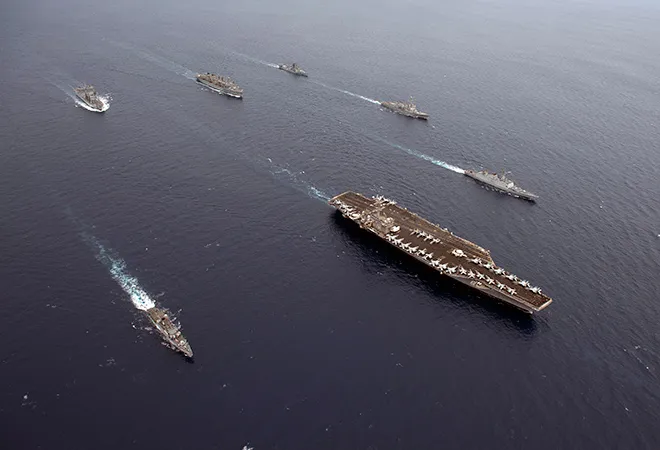The “quadrilateral” is back, and with a verve that is making strategic pundits sit up and take notice. After reports emerged last week that Japanese Prime Minister Shinzō Abe would propose a four-way dialogue between the US, Japan, Australia and India during President Donald Trump’s visit to Tokyo this week, there is speculation in New Delhi that the new “quad” might seek to counter Chinese naval power in Asia. Indian analysts say New Delhi might be willing to experiment with the idea of a countervailing alliance if it addresses India’s power imbalance with China. India’s expansion of the Malabar Exercises to include the Japanese navy and the reinvigoration of defence ties with Tokyo and Canberra, they suggest, is a sign that Indian policymakers are amenable to the idea of hard-balancing in Asia.
Yet, the prospects for an Indo-Pacific “concert of democracies” in maritime Asia aren’t strong. A closer look at emerging naval dynamics in Asia makes clear that the maritime “quad” isn’t still a wholly viable proposition. First, neither Japan nor the US has given any indication that the new grouping will have a China-centric security agenda. Earlier this week, a senior US administration official rejected suggestions that the “quad” alliance was about containing China. If anything, reports from Tokyo and Washington suggest the group might be focused on finding an alternative to China’s Belt and Road Initiative (BRI).
The second reason why India’s nautical observers might have to wait longer for their “quad” moment is Washington’s indifference to the geopolitics of maritime South Asia. Nearly a year into Trump’s presidency, the US is yet to address New Delhi’s key concerns in its near-littorals, including China’s growing footprint in Sri Lanka, Bangladesh and Myanmar, the Indian Navy’s inability to track Chinese submarines in the Bay of Bengal, and the strengthening China-Pakistan nexus in the Arabian Sea. Indian analysts say Washington’s real equities reside in the Western Pacific, where senior US officials expect New Delhi to play a larger security role. But even in East Asia, the Trump administration is looking circumspect, with a growing dependence on China to solve vexing problems like North Korea. From an Indian standpoint, the more Washington needs Beijing to negotiate with Pyongyang, the less leverage it has in shaping China’s strategic choices in the Indian Ocean.
New Delhi won’t be surprised if Trump’s promotion of a “free and open Indo-Pacific region” is more focused on trade, than maritime security.
With rising angst among Apec (Asia-Pacific Economic Cooperation) members over Trump’s decision to withdraw from the Trans-Pacific Partnership (TPP), Washington is under pressure to underline its commitment to the economic development of the Asia Pacific. Even if the US wanted to signal a hardening of maritime posture in Asia, it is likely to be dissuaded by Asean (Association of Southeast Asian Nations), which is showing a new enthusiasm for naval engagement with Beijing (evidenced by the first joint China-Asean maritime search and rescue exercise in the South China Sea last month). With many South-East Asian states openly acknowledging China’s role in regional security and development, it seems unlikely a proposal aimed at the containment of Chinese naval power in Asia will find much support—regardless of Beijing’s real and perceived violations in the disputed littorals.
The third reason why New Delhi might have to wait longer for a four-way naval alliance is the lack of clarity over what a naval quadrilateral really means for Indian interests. For the US and its Pacific partners, the maritime “quad” is a concept aimed at the joint implementation of a rules-based order in Asia. For India, however, the endeavour is an opportunity to develop its military capabilities to secure the Indian Ocean, a primary theatre of strategic interest. However, with Japan no longer in contention for the India’s submarine project P-75 (I), and US defence firms still unwilling to part with proprietary technology (including vital anti-submarine warfare know-how), the proposal for a close maritime cooperation holds little promise for improving India’s underwater surveillance and combat prowess.
Finally, if there is a need for a balancing coalition in Asia, it must happen only when the threat becomes clearer. Despite an expansion of PLAN (People’s Liberation Army Navy) activity in the Indian Ocean Region, China does not pose a physical threat to Indian interests (not for the moment). Chinese naval assets haven’t challenged Indian sovereignty in its territorial waters, or ventured close to Indian islands with malign intent. Nor have PLAN ships and submarines impeded the passage of Indian merchantmen in the regional sea-lanes and choke-points. To the contrary, the Chinese navy has avoided any entanglement with Indian naval ships in the subcontinental littorals, limiting its ventures to friendly countries in the region, many of which are happy to benefit from Beijing’s economic and military power.
This does not mean India’s grievances with China are invalid. New Delhi is rightly concerned about Beijing’s use of its navy to normalize Chinese dominance of the littorals, a condition that supports Beijing’s vision of a unipolar Asia.
Indian maritime observers are convinced that China’s maritime strategy in the Indian Ocean involves a “slow choke” of New Delhi’s geopolitical influence in its strategic backyard. But Beijing is going about its business carefully, ensuring that its military presence in the Indian Ocean Region (IOR) does not cross the threshold of conflict with India. Whatever the impact of China’s naval expansion in South Asia on New Delhi’s geopolitical and strategic equities, it does not constitute an intrusion for which Beijing can be held legally, politically or militarily accountable.
At the first quadrilateral discussion in the Philippines next week, India will observe how far Japan, Australia and the US are willing to take substantive cooperation forward in the Indian Ocean. The turn of events at Manila will determine whether and how New Delhi will expand its trilateral Malabar naval exercise with the US and Japan to include Australia.
For the moment, the maritime-quad remains an idea whose time still hasn’t arrived.
This commentary originally appeared in Live Mint.
The views expressed above belong to the author(s). ORF research and analyses now available on Telegram! Click here to access our curated content — blogs, longforms and interviews.




 PREV
PREV


